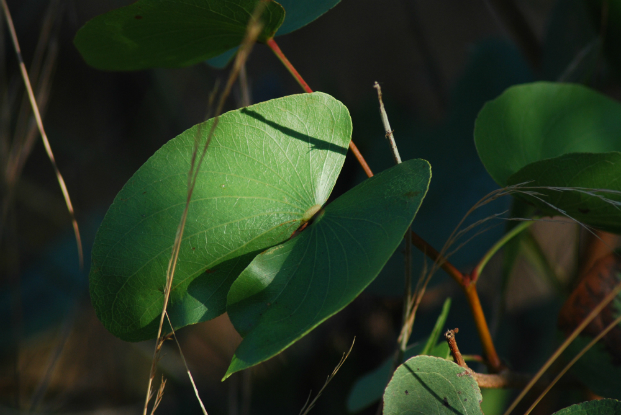
Mopane can take the form of a shrub or a tall tree with a narrow crown. Whatever the shape it will dominate the area with little else growing around it. They have kidney-shaped pods and distinctive butterfly-shaped leaves which turn from a vibrant green to a golden brown in autumn. The tree is prevalent in hot, dry, low lying areas of clay-like soil.
Fascinating overview of the mopane tree by the African Plan Hunter
Solid as iron, with a leaf like a butterfly, the scent of a pine tree and the bacteria-killing properties of bleach. Gus, the African Plant Hunter, introduces the mopane (Colophospermum mopane) tree.
Video length: 1 minute 55 seconds. Video source: The African Plant Hunter
8 facts about the mopane tree
1. Water conservation
To conserve water on hot or windy days the 2 sides of the mopane leaf will limit evaporation by folding together and thus reducing the surface area that is exposed.
2. Mopane bee
The 4mm long mopane bee (Plebina denoita) causes an annoyance to people when it swarms. In search of moisture they will try to crawl into people’s eyes, nose and mouth. On the plus side they produce a small amount of edible honey.
3. Protein content
Green leaves of the mopane are very high in protein as too are the dry fallen ones which retain 40% of their original protein.
4. The edible mopane psyllid
The juvenile stage of the sap sucking insect, mopane psyllid (Arytaina Mopani) produces a sweet-tasting waxy cover which is eaten by people.
5. Leaf shape
The scientific name for the mopane tree is derived from the Greek word Colophospermum which means oily seed and mopane which is the Shona word for butterfly, refereing to the shape of its leaves.
6. Mopane worm
The 10 cm long mopane worm which cover mopane trees in summer offer a great revenue source to the rural economy, this large caterpillar of the emperor moth (Gonimbrasia belina) is either roasted or dried before being eaten along with maize as a high protein meal.
Kruger National Park is connecting with the community by allowing nearby villages to harvest Mopani worms in the Park.
Video length: 34 seconds. Video Source: SABC News
7. Gonometa caterpillar
The cocoons spun by the Gonometa caterpillar (Gonometa rufobrunnea) are harvested for their silk from mopane trees.
8. Dense wood
Mopane is one of the heaviest woods in South Africa weighing in at more than 1 ton per cubic metre.
The symbiotic relationship between the mopane tree and elephants.
Gus shows how mopane trees respond to elephants browsing by releasing tannins from their roots to make the leaves unpalatable. They also release pheromones to alert other trees nearby to the incoming elephant. But elephants have also got wise to this.
Video length: 2 minutes 50 seconds. Video source: The African Plant Hunter
Vote for the fact you find most fascinating
Green leaves of the mopane are very high in protein as too are the dry fallen ones which retain 40% of their original protein.
The cocoons spun by the Gonometa caterpillar (Gonometa rufobrunnea) are harvested for their silk from mopane trees.
Mopane is one of the heaviest woods in South Africa weighing in at more than 1 ton per cubic metre.
The 10 cm long mopane worm which cover mopane trees in summer offer a great revenue source to the rural economy, this large caterpillar of the emperor moth (Gonimbrasia belina) is either roasted or dried before being eaten along with maize as a high protein meal.
The juvenile stage of the sap sucking insect, mopane psyllid (Arytaina Mopani) produces a sweet-tasting waxy cover which is eaten by people.
The scientific name for the mopane tree is derived from the Greek word Colophospermum which means oily seed and mopane which is the Shona word for butterfly, referening to the shape of its leaves.
The 4mm long mopane bee (Plebina denoita) causes an annoyance to people when it swarms. In search of moisture they will try to crawl into people’s eyes, nose and mouth. On the plus side they produce a small amount of edible honey.
To conserve water on hot or windy days the 2 sides of the mopane leaf will limit evaporation by folding together and thus reducing the surface area that is exposed.






